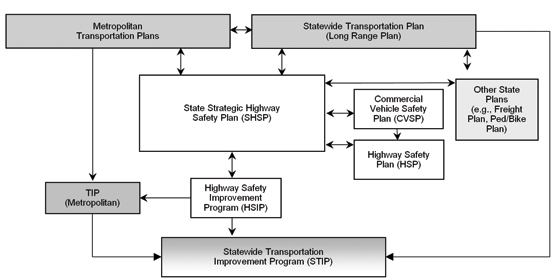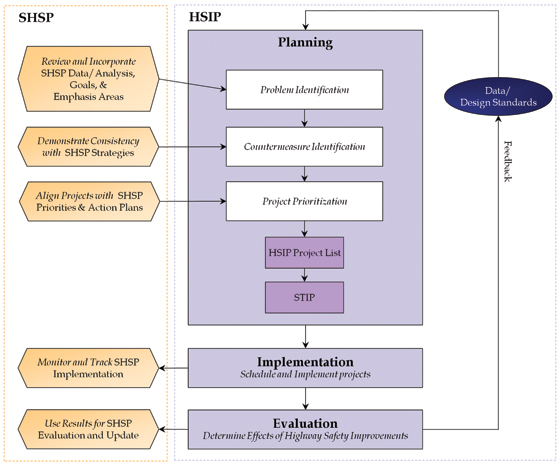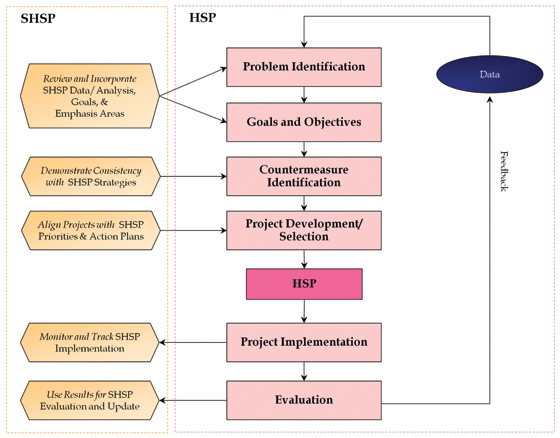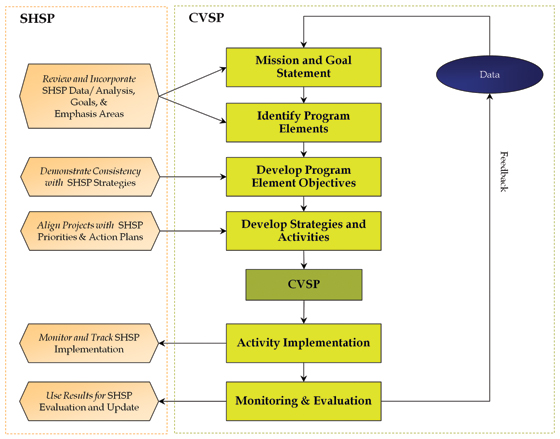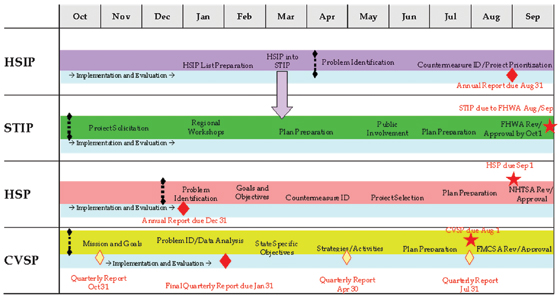5.1 Long-Range Transportation Plans and State/Transportation Improvement Programs
LRTPs and S/TIPs prepared at both the State and MPO levels provide guidance for improvements to transportation facilities and systems. They typically present a multimodal set of capital, operations, and systems management strategies for transportation facilities within their geographic areas. LRTPs may include policies, strategies, and future projects; projected demand for transportation services over periods of 20 years or more; a systems-level approach that considers roadways, transit, nonmotorized transportation, and intermodal connectors; Statewide and regional land use, development, housing, environmental and employment goals and plans; cost estimates and reasonably available financial sources for operations, maintenance, and capital investments; and strategies to preserve existing facilities and make efficient use of the current transportation system.
TIPs and STIPs are short-range (covering a period no less than four years and updated, at minimum, every 4 years), fiscally constrained programs of transportation improvements. Programs and projects included in S/TIPs must have identified funding sources. TIPs from each MPO are incorporated directly, without change, into the State STIP. Through an established process, the State DOT identifies projects from rural areas, smaller urban jurisdictions, and areas of the State outside of its MPOs for inclusion in the STIP. Development of a transportation plan sensitive to safety issues creates opportunities to improve the strategies used by agencies to design and operate the transportation system. For example, incorporating the SHSP into the S/TIP development process can lead to implementing additional strategies that positively affect crash rates and increase focus on safety by incorporating safety evaluations of project alternatives prior to final design selection.
Figure 5.2 illustrates the relationship between the SHSP and the transportation planning process. The SHSP should influence the transportation plan’s visions and goals, alternative improvement techniques, and evaluation and prioritization strategies. Systems operations and project implementation activities should provide feedback to the SHSP. This feedback enables SHSP managers to improve future transportation planning efforts.
Figure 5.2 Relationship Between SHSP and the Transportation Planning Process
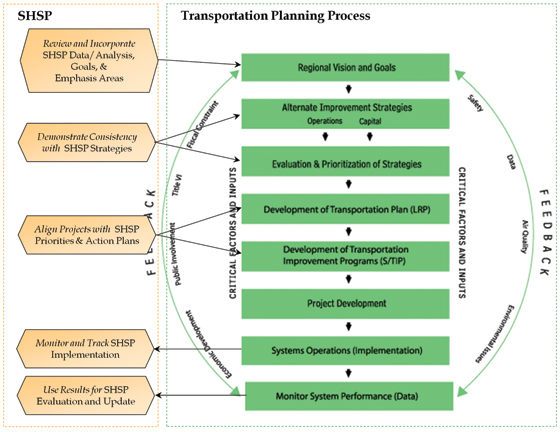
Establish Regional Vision Statements and Goals
Transportation planning begins with a vision, which typically consists of general Statements describing desired end-states. For example, most planning visions highlight the need for a safe and secure transportation system that provides mobility and accessibility.
The LRTP vision is important to SHSP implementation efforts because it sets the tone for the overall planning process and outlines the needs considered when evaluating alternative transportation options. Since the S/TIP and LRTP must be consistent, the vision from the LRTP is carried forwarded into the S/TIP. Visions for LRTPs and S/TIPs should include statements about the importance of safety. To make this happen, the SHSP stakeholder group should be engaged in these planning processes early to promote consideration of safety during the visioning process. Prototype vision statements that include safety language should be presented to raise awareness at public meetings, board meetings, or in other forums where the visioning process is taking place.
SHSP stakeholders can attend monthly meetings of the State MPO association and encourage them to include safety on the agenda at every meeting. Some MPOs involve the DOT traffic safety division during development of the LRTP to coordinate safety planning. MPO personnel serve as regional safety ambassadors to local governments and increase awareness by incorporating safety pages on their Web sites. Transportation Safety Planning (TSP) activities at the State and regional level will improve the safety component in MPO transportation planning efforts. Peer exchanges with other States can provide valuable feedback and encouragement to MPO and DOT personnel working to integrate the SHSP with LRTPs and S/TIPS.
Goals and objectives provide guidance to subsequent planning efforts and help assess the relative contribution of alternatives toward achieving desired safety improvements. Properly developed goals and objectives also lead to the identification of criteria for evaluating options and alternatives. SHSP goals and emphasis area objectives set quantifiable targets for Statewide priorities and should be adopted into the LRTP verbatim or, at a minimum, should be clearly reflected in the transportation planning process based on safety data and analysis.
Involving MPOs in SHSP implementation efforts provides critical local and regional input. In turn, some MPOs are beginning to institutionalize safety by establishing safety committees and adopting safety resolutions that support the SHSP. Some MPOs are developing Regional Safety Action Plans in conjunction with the SHSP.
Identify Alternate Improvement Strategies
The next step in the transportation planning process is to identify the strategies needed to achieve the desired safety improvements. Safety strategies and projects within both the LRTP and the S/TIP should be consistent with SHSP goals and objectives. The adoption of these strategies and projects improves the effectiveness of the LRTP and S/TIP development processes and ensures consistency among them with respect to safety.
Evaluate and Prioritize Alternative Strategies
Evaluation is the process of synthesizing information on benefits, costs, and impacts so judgments can be made concerning the relative merits of alternative actions. In the same way that including safety in the vision statement is important for setting planning priorities, including safety in evaluation criteria is essential for ensuring real action is taken to address safety problems. Most evaluation efforts use one of three methods:
- List the evaluation criteria and show how the alternatives compare.
- Assign weights or scores to the evaluation factors.
- Conduct benefit/cost analyses.
It can be worthwhile to meet with planning officials at both the DOT and MPO levels to discuss how safety considerations are best incorporated into project selection and prioritization activities. One way to do this is to establish a project prioritization process that takes the safety benefits of a project into account and assigns weighting or scoring in the selection of projects. Weighting may attempt to account for the value of lives saved and/or crashes reduced within the context of other prioritization factors, such as congestion relief and air quality improvement. Ranking can be based on comparison of crash rates or crash severity at proposed project locations.
Develop Transportation Plans and Transportation Improvement Programs
The statewide LRTP can range from a relatively simple statement of investment policies, and strategies to a detailed master plan outlining specific investments to be made over the plan’s life (usually 20 years). The metropolitan LRTP typically identifies specific projects and transportation corridors where improvements are necessary.
The STIP and TIP are connected to the LRTPs through a process called programming. Programming matches desired actions with available funding through a priority-setting process. This S/TIP priority-setting process is undertaken with contributions from a multitude of stakeholders interested in a wide variety of issues. To ensure safety is part of the prioritization effort, SHSP stakeholders need to be part of the priority setting process.
Incorporating the SHSP into the LRTP and S/TIP impacts the degree to which SHSP goals, objectives, and strategies are implemented. LRTP and S/TIP projects should be aligned with SHSP strategies and action plans. LRTPs and S/TIPS may significantly impact transportation safety by targeting appropriate groups for education efforts, enhancing traffic enforcement activities, providing improved data collection and management efforts, conducting studies on corridors or areas where safety is of particular concern, and considering additional regulations to promote transportation safety.
Some MPOs use SHSP emphasis areas as an input in the development of their annual Unified Planning Work Programs (UPWP), and some are developing their own safety work plans. These work plans identify specific programs, activities, or tasks to encourage local involvement in safety planning. Some States require documentation that explicitly shows that STIP projects utilizing HSIP funds are directly linked to the SHSP, either as a specific project or countermeasure. Some States fund safety projects through the use of funds from other sources, such as the Congestion Mitigation and Air Quality Program (CMAQ).
Once projects reach the last three phases of the transportation planning process (project development, operations, and monitoring), the SHSP is used as a tool to ensure resources are aligned with safety priorities and as a benchmark for monitoring system performance. The strategies in the SHSP should guide the safety elements that are incorporated in the project development phase of a project. In the operation phase the SHSP strategies should help to ensure safety movement of traffic during and after construction.
Key Integration Strategies – LRTP and S/TIP
- Meet with planning officials at the DOT and MPO levels to discuss how to incorporate safety considerations into project selection and prioritization activities.
- Participate in DOT and MPO visioning exercises to ensure safety is explicitly addressed.
- Develop prototype vision statements that include safety language for presentation at DOT and MPO visioning exercises, MPO board meetings, public involvement meetings, and other forums to raise awareness.
- Encourage the adoption of SHSP goals, objectives, and performance measures.
- Provide the results of research and analysis conducted during the SHSP development process to identify strategies and projects for inclusion in LRTPs and S/TIPs.
- Offer to serve on committees and teams that prepare and influence transportation plans.
- Support MPO transportation safety planning forums to review crash data, introduce the SHSP, and discuss how safety can be integrated into their planning documents.
- Attend statewide and local MPO board meetings to encourage a focus on safety.
- Encourage MPOs to establish safety committees, adopt safety resolutions in support of the SHSP, and develop regional safety action plans reflecting appropriate elements from the SHSP.
- Encourage and participate in the establishment of project prioritization weighting or ranking schemes that explicitly address safety considerations.
- Encourage MPOs to use the SHSP emphasis areas as a source for programs in their annual Unified Planning Work Programs.
- Ask the DOT and MPOs to require explicit documentation showing how S/TIP projects utilizing HSIP funds are directly linked to the SHSP.
- Use peer exchanges to learn from the experiences of other States.
|












